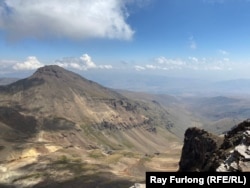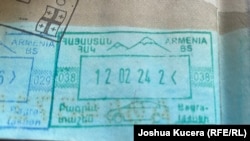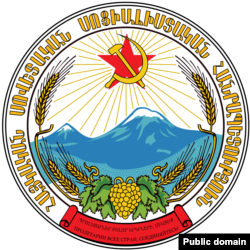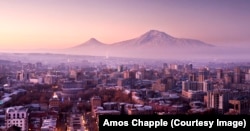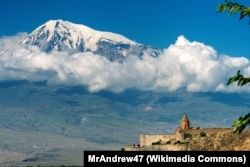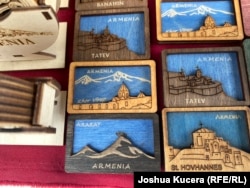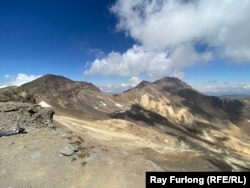YEREVAN -- Armenian Prime Minister Nikol Pashinian recently posted an innocuous-seeming photo on his Instagram page: a snowy mountain with the caption "Aragats. The highest peak of the Republic of Armenia, 4.090 meters."
In another time, it might just have looked like a simple bit of geographical trivia. In today's Armenia, though, Pashinian's praise of Mount Aragats represents a direct challenge to the nation's identity.
Commenter after commenter pushed back against the prime minister's Instagram claim. It wasn't Armenia's highest mountain, they argued. That was "Ararat," one commenter wrote. "We shall not betray our mountains."
Mount Ararat is, in fact, taller than Aragats by more than 1,000 meters. The catch, though, is that it is not in the Republic of Armenia but just across the Turkish border. It would be difficult, however, to exaggerate Ararat's significance to Armenians: It is the mythical birthplace of the Armenian people and a poignant symbol of the tragedy of their 20th-century history. Ararat continues to loom majestically over the capital city of Yerevan, providing an iconic setting for numerous photographs.
But that historic significance, Pashinian now argues, has become a burden on Armenia as it tries to forge a new future, following disastrous military defeats to Azerbaijan and the loss of the territory of Nagorno-Karabakh.
Ararat, he said in one speech, represents no less than the "duality that exists in each of us: historical Armenia and real Armenia." The question for Armenians now, he said, is: "Should the real Armenia serve the historical Armenia or should the historical Armenia serve the real Armenia?"
Pashinian did not stop at the Instagram post. He demonstratively hung a massive painting of Mt. Aragats in his office and called on Armenians to also honor the mountain. He and other top officials have suggested that Ararat's official role be downgraded, questioning why it is at the center of Armenia's official coat of arms.
"All of our problems -- absolutely all of our problems -- are in between Ararat and Aragats," he said.
It remains unclear precisely what Pashinian's ultimate agenda is vis-a-vis Ararat. But his recent efforts have dovetailed with other initiatives that also seek to redirect Armenians' gazes away from long-cherished past glories and toward their current country.
It's a deeply ambitious -- and, his allies say, overdue -- effort to rewire Armenians' national identity. But the prime minister is undertaking it precisely at a time when Armenians feel their nation is more threatened than ever.
"He's saying our problems are our symbols, our understanding of our own history. There's some truth to it, no doubt about it," said Arsen Kharatian, a journalist who was Pashinian's first foreign policy adviser after coming to power in the 2018 Velvet Revolution. "But why do you choose to do it right now and demoralize your society even further?"
Cradle Of Armenian Civilization
Ararat's central role in Armenian identity dates back to the fifth century, when historian Khorenatsi wrote that Armenians were the direct descendants of the biblical Noah through his son Japheth. According to the legend, Japheth's descendant Haik defeated the evil Babylonian king Bel at the foot of Mount Ararat. That legend, according to historian Razmik Panossian, "makes Mt. Ararat the national symbol of all Armenians, and the territory around it the Armenian homeland from time immemorial."
Originally, though, Ararat -- that is, the mountain where Noah's Ark supposedly ran aground and Haik battled Bel -- was thought to be a different peak, further to the south. It was only in the Middle Ages, under the influence of Crusaders and Catholic missionaries, that Ararat began to be identified with the mountain it is today.
Political control of the mountain also shifted over time. Ararat was part of the great Armenian kingdoms of antiquity, but after those states fell, it came under the control of various different empires. For the second half of the last millennium, its western foot lands were in the Ottoman Empire, while the peak itself and the lands to its east were in the Persian and then Russian empires. While the rulers of Ararat changed over the centuries, the Armenians remained.
Centuries of Armenian life around Ararat came to an end during World War I with the Ottoman state-led killings and deportations commonly referred to as the Armenian genocide. And when the region's borders were redrawn after the war, Ararat ended up in the new Republic of Turkey.
But the Soviet Armenian leadership, as well as their bosses in Moscow, sought (ultimately unsuccessfully) to regain the former Russian territory, including Ararat, that had ended up in eastern Turkey. Mt. Ararat featured on the coat of arms of the Armenian Soviet Socialist Republic, giving rise to the apocryphal story of a Turkish official complaining to his Soviet counterpart that the symbol amounted to a territorial claim on Turkey. The Soviet official retorted that the Turkish flag has the moon on it.
The Armenian Genocide Memorial, which was built in Yerevan in 1967, is oriented to face Ararat. Some dissident Soviet Armenian nationalists even used a dating system using Haik's victory over Bel, supposedly in 2492 B.C., as the real year zero, meaning that 1989 was the Armenian year 4481. The borders of Soviet Armenia "increasingly constituted a publicly questionable injustice, the articulation of which flowed seamlessly into the legitimacy of the republic's elite," wrote scholar Laurence Broers.
Brandy And Cigarettes
In independent Armenia, Ararat has become a ubiquitous symbol. It has given its name to prominent brandy and cigarette brands. Armenia's passport stamps feature the mountain's image. It is a common male name, including that of the current foreign minister, Ararat Mirzoian. It is so beloved that real estate prices are said to double if a home has a view of Mt. Ararat.
Pashinian's preferred mountain, Aragats, is well-liked enough. It is a popular high-altitude weekend destination for Yerevan residents; its four peaks can be hiked in one day, and it is now the site of a new ski resort. But it has none of the symbolism of Ararat.
"Before I moved here, I had never heard of Aragats," said Richard Giragosian, the Armenian-American head of the Yerevan-based tank Regional Studies Center think tank.
At the Vernissage market in central Yerevan, where tourists come to buy their Armenian souvenirs, images of Ararat's majestic, snow-capped double peaks are everywhere. One vendor, Vazgen Shahbazian, had several Ararat paintings for sale. Asked about Pashinian's comments on the mountain, he was skeptical.
"If your son moves to France, do you forget about him?" Shahbazian asked. "No, and we also aren't going to forget [Ararat]," he said.
Opinions differ, though, about what precisely Ararat means to Armenians.
"What does it matter which country the mountain belongs to?" asked journalist and peace activist Arpi Bekarian. "We look at it every morning when we wake up. Every great view in Yerevan opens to Ararat. It's an everyday symbol for us, not something mythical.
"If [Pashinian] takes it off the coat of arms, are we going to stop seeing Ararat from every corner of the city? Are we not going to want to sing or write about the mountain that is a part of our identity?"
There are still ambitions -- albeit hazy ones -- of someday regaining the territory.
"The main Armenia is there, not this one," said Vardan Tovmasian, a coach at a sports school in Yerevan. Asked if Ararat should become part of Armenia again, he agreed: "Yes, this is the dream of every Armenian," he said. "How often does the world map change? Never say never."
A New Direction
It was in May 2023, when Pashinian started the conversation about Mount Ararat. With cameras rolling, he asked a group of children sitting around a campfire what the highest mountain in Armenia was. There was a jumble of tentative responses, and Pashinian seized on the teachable moment.
"See, some of you said Ararat, and some of you said Aragats. Those who said Ararat spoke about a different thing. Those who said Aragats spoke about the Republic of Armenia. We all get confused in distinguishing between the notions of homeland and state," he said, as the children listened politely. "We constantly have to make a choice between a homeland and a state. Our choice must be in favor of the state, because if we don't make our choice in favor of the state, we will constantly be losing."
Not long afterward, he mentioned the campfire chat at a press conference.
"In Turkey, they say, 'Wait a minute, Turkey is a territory within internationally recognized borders. And if these children today say that Armenia's highest mountain is Mt. Ararat and not Mt. Aragats, does it mean that the Republic of Armenia has territorial claims on Turkey?'" he said.
Pashinian's comments garnered little attention at the time -- the Armenian leader has a reputation for freewheeling commentary -- and he dropped the topic soon after. In recent weeks, though, he has begun discussing it again. And this time it is in a political context that has become considerably more fraught, following Azerbaijan's lightning military offensive in September last year that resulted in the Karabakh's leadership's full surrender and the exodus of more than 100,000 ethnic Armenians.
Toward the end of the Soviet period, Armenians questioning their borders looked not west, to Ararat and Turkey, but east, to Azerbaijan and the mainly ethnic Armenian-populated Nagorno-Karabakh, then an autonomous oblast within the Soviet republic of Azerbaijan. In 1988, nationalist Armenians launched the Karabakh Movement, demanding that the territory be joined with what was still then the Armenian Soviet Socialist Republic.
Azerbaijanis resisted, and in the war that resulted, Armenian-backed separatists managed to seize Nagorno-Karabakh. They also took control of seven adjacent Azerbaijani districts, forcing the entire population of more than 600,000 ethnic Azerbaijanis to flee. Diplomatic efforts to settle the conflict brought little progress over the years, and in 2020 Azerbaijan launched another war, resulting in its retaking the seven adjacent districts and parts of Karabakh itself.
Following the capitulation of the Karabakh leadership in September 2023, Armenia and Azerbaijan are now in talks to agree to a peace treaty, and as part of that process Azerbaijani President Ilham Aliyev has repeatedly spoken of the need to uproot any vestige of Armenian "revanchism" -- the ability or will of Armenians to try to regain control over the territory.
"We need firm, verified guarantees that there'll be no attempt of revanchism in Armenia. Why do we need it? Because we know what is happening in Armenia," the Azerbaijani president said in December 2023. One senior Aliyev adviser warned that Armenians having territorial claims "in the back of their minds" would spoil a peace deal.
At the same time, Aliyev has been making his own veiled claims on Armenian territory, arguing that Armenia represents historical "Western Azerbaijan" and calling on Azerbaijanis to be able to return to their former homes there. Those claims, along with continued tension along the border and apparent delays in signing the peace agreement, have all led to fears among Armenians that Azerbaijan could have its own designs on their territory.
Azerbaijani Demands
It is in this context that Pashinian has renewed the conversation about Ararat and Aragats. He posted the Instagram photo on January 26, around the same time that he started showing off the new giant painting of Aragats in his office. At the same time, he has also started several new discussions that all appear oriented toward turning Armenians' gazes inward rather than outward.
He has proposed changing the name of the school subject from "Armenian History" to "History of Armenia," arguing that that framing would put a tighter focus on the Armenian state. And he has proposed changing the constitution, including a reference in the current document to a 1989 declaration of independence that calls for the unification of Armenia and Karabakh. The declaration that Pashinian has mulled changing also calls for the 1915 killings of Armenians "in Ottoman Turkey and Western Armenia" to be recognized internationally as genocide.
Keeping those provisions in the constitution "means that we'll never have peace," Pashinian said in a January 31 interview with Armenian public radio. "It means that we will have war now."
The next day, President Aliyev said publicly that Azerbaijan had demanded those references be removed from the constitution as a condition for signing a peace deal. To many, that confirmed suspicions that Pashinian's efforts were being done at the behest of Baku and Ankara.
"This is a puppet government, managed by Azeris, and it is carrying out Azeri demands to change the constitution and our national symbols," said Artur Khachatrian, a parliamentary deputy from the opposition Armenian Revolutionary Federation (Dashnaksutyun) party.
Pashinian himself has frequently framed the Ararat and related questions as, if not a direct demand from Armenia's nemeses, an issue that is an unnecessary annoyance to Ankara and Baku and which Armenians should resolve for their own benefit.
In the January public radio interview, Pashinian used an elaborate metaphor to describe the need to change the constitution.
"We are walking along a road and see bulls standing on both sides of the road. We look at each other and see that we are all dressed in red. And these red clothes were knitted for me by my late, beloved grandma. And I was in these clothes all my life, and they have become somewhat of a mascot for me. We should discuss this and make a decision," he said. "By changing our red clothes, we do not get a guarantee. By wearing the red clothes, we get a negative guarantee. But by wearing some other clothes, we get a chance, not a guarantee. And if we act wisely, we will turn this chance into a guarantee."
His comments caused a stir among the Armenian political class, and the director of the radio network, Garegin Khumarian, responded with an essay apologizing for the interview. He wrote that the interviewer should have challenged Pashinian about the comments and that he had been reassigned as a result.
"Last week, in this [recording] booth, we were asked to stop being what we are," Khumarian wrote. "We were told that Turks are strong, Armenians are weak, and Turks massacre Armenians. This syllogism should have led to the conclusion, 'Let's get stronger,' but instead it sounded like, 'Let's stop being Armenian.'" The essay was published with a photo of Khumarian wearing a red sweater.
Some of Pashinian's justifications for change have heightened the skepticism about his intentions. He said that children learn in state schools that Ararat is the highest mountain in Armenia; a fact-checking organization found that school textbooks in fact identify Aragats as such. He said the initiative to change the name of the history textbooks came from a group of teachers; leading historians, however, have cast doubt on that claim and the teachers have never come forward. And the grammatical difference in Armenian between "History of Armenia" and "History of Armenians" is not as significant as Pashinian portrays it. (Officials at the Education Ministry did not respond to e-mails from RFE/RL seeking clarification.)
Asked for a clearer explanation of what Pashinian's thinking is on Armenia's dueling mountains, the government's press office made available Maria Karapetian, a member of parliament and close ally of the prime minister.
In an interview, Karapetian -- who had a long background in Armenia-Azerbaijan and Armenia-Turkey peace initiatives before entering politics -- denied that the government's stance on national identity was a result of external pressure.
"This is not a topic for bargaining," she said. "This is important for us to talk about, regardless of what happens around us."
Many narratives about Armenia's history, including those taught in the country's schools, are oriented around the idea of "national liberation," she said, which is no longer relevant in today's Armenia.
"National liberation movements end, and they end with the establishment of statehood. We have completed this process," she said. "Our problem is that there are political forces within Armenia, and outside of Armenia, who contest this, who speak with contempt about the Republic of Armenia, because it is too small if we compare it to our national dreams from the national liberation struggle."
The government's goal, she argued, is to "calm the political mind" in Armenia, so that "politicians and the citizens of Armenia don't see a possibility to bring history, or parts of it, up as a political agenda."
While this ideological reorientation has proven controversial among Armenia's political class, ordinary people are likely to welcome it, Karapetian argued.
"What we learn in school is very well deconstructed by our lived reality," which gives people a more "pragmatic" approach to national issues, she said. "It's just that, when you turn on the cameras and microphones and someone feels like they bear the responsibility for the fate of the Armenian people, they start reproducing the dominant narratives…. If you turn it all off, then the pragmatic, lived reality" comes through.
Where To Now?
Pashinian came into office wildly popular, with an 82 percent approval rating in 2018, according to a poll from the International Republican Institute (IRI). The repeated defeats to Azerbaijan have badly wounded him, though; the most recent IRI poll found that a mere 13 percent of Armenians trusted Pashinian -- and that was before the September 2023 capitulation. The same polls, however, show that the opposition is even less popular and repeated challenges to Pashinian have all fizzled quickly.
Pashinian has not made it clear where he intends to take this process beyond the conspicuous shifts in rhetoric. He has mooted the idea of holding a constitutional referendum; in addition to the references to unification, the constitution also specifies the design of the official coat of arms, which includes the Ararat image. After Pashinian made his initial comments about the school textbooks, the Education Ministry said the only thing under discussion was the title, not the content of the courses. But Karapetian said that the textbooks should be changed based on guidelines provided by the state.
The rhetorical shift is somewhat similar to how Pashinian gradually changed the way he spoke about Nagorno-Karabakh after the 2020 war. In retrospect, that served to gently accustom Armenians to the idea that they would have to give up on the idea of political control of the territory. Every few weeks, without much ado, Pashinian would roll out a new suggestive phrase implying -- but not spelling out explicitly -- a retreat from Armenians' previous hard-line positions.
Some critics worry that this initiative could be going the same way.
"Today, Azerbaijan orders this government to take Ararat off the coat of arms," said Khachatrian, the opposition deputy. "We don't know what's going to happen tomorrow."
And that it is Pashinian leading this process is ironic, given some of his rhetoric before the 2020 war. Pashinian came to power on the back of street protests in Armenia's 2018 Velvet Revolution. A rabble-rousing journalist before he entered politics, he had little experience in foreign policy. The regime he overthrew was led by men closely associated with the Karabakh war in the 1990s who, out of power, formed the backbone of a nationalist opposition to Pashinian, along with the diaspora-based Dashnaksutyun party. They attacked him as being soft on Karabakh, and he responded by taking more hard-line positions than they had.
"[Pashinian and his team] change their political ideology and political statements like I change my socks every morning," Khachatrian said. In 2019, Pashinian himself declared that "Karabakh is Armenia" and led a crowd there in chants of "miatsum," an Armenian nationalist slogan referring to the unification of Karabakh and Armenia. It was further than any previous leader had gone.
And in 2020, just six weeks before Azerbaijan's attack, he marked the 100th anniversary of the Treaty of Sevres, in which global powers had carved up the remnants of the Ottoman Empire into pieces, including an expansive Armenia that stretched from Karabakh in the east to west of the Turkish city of Trabzon. The treaty was never implemented, but its vision of Armenia continues to be an inspiration to Armenian nationalists.
Pashinian praised the treaty as a "historical fact that reflects our long journey to restore our independent statehood" and said "we are bound by duty to remember it, realize its importance, and follow its message."
The statement drew a sharp rebuke from Turkey's Foreign Ministry.
"It is time for the authorities of Armenia to abandon aggressive nationalist and jingoist policies and come to their senses," the statement concluded.
Even some of Pashinian's allies have not been on board with this new direction. Ruben Rubinian, the deputy speaker of parliament and Pashinian's envoy on normalizing fraught relations with Turkey, has said he opposes changing the coat of arms.
"It is a fact that Armenia's highest peak is Mt. Aragats. It doesn't mean that Mt. Ararat has no symbolism for us," he said in a television interview.
"This debate will not take us to a good place, because it will divide people," said Edmon Marukian, an Armenian ambassador-at-large working on negotiations with Azerbaijan. "I don't think that it's a good idea."
Following this interview, Marukian resigned his post, citing "the difference in [his and Pashinian's] visions regarding a number of fundamental foreign policy issues in recent months."
"You have opened a Pandora's box, and you cannot stop it," said Kharatian, the former foreign policy adviser. "It's going to anger people a lot more."
